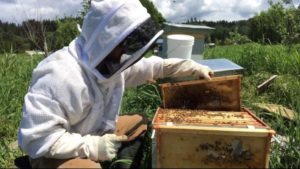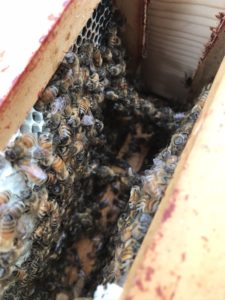We frequently hear the rallying cry of “save the bees!” But what does that look like and why are bees so important in the first place?
Thanks to a tip from one of the fine folks over at “Look, Listen, Learn” — check out our profile on Val Thomas-Matson — we learned about Robin David, a beekeeper for Best Bees who helped us understand the answers to these questions and more.
This interview has been edited for length and clarity.
How did you get into beekeeping?
I used to be an engineer, and I kind of got to the point where I just wasn’t having fun. I decided that if I could be this good at engineering — which is something I don’t care about — how good could I be at something I do care about? But I didn’t know what those things were, so I took myself out of work, saved some money, started going to school.
A friend of mine had a friend who was a beekeeper who was leaving town and just wanted to give away his hive and what turned out to be thousands of dollars of equipment. So I just started there and got into beekeeping.
What is Best Bees?
We’re a company that does beekeeping services for residential clients and some corporate clients. We’ve got this thing “HoneyDNA” that takes samples from honey pulled from hives and then analyzes it at a lab and gives you a kind of 23andMe response back saying 90% of your bee’s honey is blackberry or it’s coming from sunflowers and that kind of information goes a long way.

What does a day look like when you check up on a hive?
The most important part is dressing the part. You never want to get stung in the ankles just because you’re like, ‘I didn’t do my laundry.’
You don’t want to be invasive; you want to have what I like to call my “zen speed” where I almost move in like slow motion. After a while you notice that they can sense you. They can sense the panic, they can sense the sweat when you get nervous. If it’s warm, it’s okay to go into the hive longer than 15 minutes, but if it’s cold you almost just want to pop the top and see what’s up. You’re just going through to see if they’re storing honey, seeing if they need more space, and if you’re lucky you can find the queen which is always a good sign.
Who is an ideal candidate to get a beehive(s)?
You gotta have a safe place for the hive. The service is hands off unless you want to participate, so really you can set the hive and forget it. If I were your beekeeper I’d check in with you beforehand, maybe bring an extra suit or helmet in case you wanted to come tag along. If you want to have beekeeping done and maybe you don’t have the time, you’d be a great fit. If you want to have beekeeping done and have someone else do it and enjoy the honey, you’d be a great fit. All the honey goes back to the customer, and in case your hive doesn’t bring in any honey we have a 10 pound guarantee at the end of the year.
What does a healthy hive look like vs. an unhealthy one?
A healthy hive is where you see a ton of bees flying in and out and they have “pollen pants.” You’ll see their little legs with saddle bags where they collect all the pollen from plants. They’re going to use that to feed, and if they’re feeding that means they’re rearing a lot of younger bees to continue on. So if you pop open the hive and it’s just full of bees and packed and you can almost not see the equipment below the bees, that’s a great sign, you know it’s thriving.
Conversely, if you see a hive with not a lot of action right in front, that’s something to worry about. You have to start thinking about problem solving. What are some things I can do to help them out? Obviously they’re having issues, and you’re their best help.

What do these hives look like that corporate clients have?
The rooftop beehives are the model. You can do one to four hives, but some of the best have multiple hives. If one hive stores a lot of honey and if they make more honey for themselves, you can help out the ones that don’t store honey just as fast.
Bees can fly up to three miles, so even though the vegetation downtown isn’t so great they can still reach places like the Arboretum or the Olympic Sculpture Park and little gardens tucked away here and there.
Why are bees so important?
The reality is that out of three bites of food you eat, one bite is essentially down the line supplied by bees in some way shape or form. Whether that’s you eating a blueberry that was pollinated by a bee or maybe that blueberry fed the animal you’re eating. It’s the importance of knowing your food and the pollinators it relies on. Also, bees are just very gentle and honey’s just really cool.
What’s one thing you want people to know about bees?
They’re important, and you can do something about it. If you can’t fit a hive in your home, just go to a seed store and buy a planter, find a patch of dirt, and throw some pollinator seeds down. It’s essentially giving food to these bees that are so important to us.